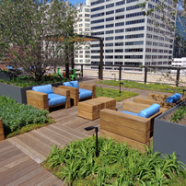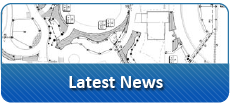Teaming up for a rooftop experience second to none…
What do you do when you have high winds, hot summers and it’s all on the roof? Green space is at a premium in Downtown Chicago, and when Hillshire Brands wanted to provide a relaxing outdoor environment for their employees they looked to the roof. Working with the team at Wolff Landscape Architecture, they designed not only an outdoor patio area, but incorporated green space and plants to bring that park-like feel to the roof. Landtech Design was included on the project to design the irrigation system for the challenging space. Not only was the new landscape being installed over the existing roof, but several of the planting areas had only 4” deep trays. The harsh environmental conditions would require constant monitoring and precise watering to ensure that the plants continued to thrive, not be overwatered or allow mist to be carried off in the wind. The client wanted to be as “green” as possible so Landtech Design selected the ESP-SMTe controller (more info) providing a weather station to monitor not only rainfall, but also temperature, historical ET and the ability to calculate the evapotranspiration data figure for each day. This allows the controller to adjust watering schedules to deliver the precise amount of water needed to maintain the optimum soil moisture and plant requirements. Additionally, with the greenroof planting trays a depth of only 4”, the plants are watered using micro-spray nozzles on 6”-7” Poly-Flex risers. Designing the piping layout had its own challenges as the only way to get from planter to planter was by using the cavity beneath the pedestal pavers allowing for only 1.5” of clearance for the irrigation lines. Irritrol 2400 valves provided the necessary low-profile and low-flow capability as necessitated by the design. (more info) This project was installed by the crew of Andrew McCann Sprinkler Company. This company has been in the Chicago area since 1917, and has a strong reputation for providing quality work, service and experience in the City of Chicago and neighboring areas. (read about McCann Sprinkler) Partnering with a great team of landscape architects (Wolff LA), irrigation consultants (Landtech Design) and a quality irrigation contractor (Andrew McCann) has guaranteed a happy, satisfied customer. “I’ve been to that office a couple times. It is just east of our place near Union Station. The rooftop garden is beautiful!” Kate Byers For your next irrigation project, consider hiring Landtech Design as your irrigation consultant. We have become known as “the landscape architect’s irrigation consultant”, bringing the latest technology to each and every project. Designing a system that meets the needs of your customers, providing water conservation and savings, along with a quality set of documents for construction is our primary...
Read More2012 Monumental Award
Landtech participates in creation of the Indianapolis Cultural Trail which was recently awarded the 2012 Monumental Award by the Indianapolis Chamber of Commerce.
Read MoreGratitude and Thanks…
From our family to yours, This year our hearts are heavy and our prayers go to the families and the community of Newtown, Connecticut as they struggle to put their lives back together after the tragedy they have suffered. As we Pray for the victims and all people who are suffering around the world we pause to reflect upon our blessings, especially the relationships in our own lives. We are thankful for the blessings of family and friends. With that in mind, we want to thank you for the business you’ve given us, but more importantly, thank you for your friendship. Friendship is a gift from God and as you pause during this holiday season we pray that every one of all faiths is able enjoy this special time and pray that you have a bright New Year. Sincerely, Mike Kenney...
Read MoreIs Subsurface Drip Irrigation Right for My Business?
Navigating unfamiliar territory can make anyone nervous. But navigating unfamiliar territory when it comes to your business can be one of the most daunting tasks you undertake. When it comes to growing trends, making the call to adopt or pass over those trends is difficult but impossible to avoid. As a landscape contractor, it is understandable that you may be hesitant to forgo the traditional sprinkler irrigation route for the unfamiliar terrain of subsurface drip irrigation systems. The reality is subsurface drip irrigation is not only a growing trend, but a smart choice. When you consider that water regulations for turf irrigation are on the rise, installing systems that maximize water efficiency is a must, especially for larger commercial and municipal projects. The fact is, water is a high value resource and regulations will continue to increase as water use continues to grow and water scarcity rises. This is not a trend that green industry professionals can afford to ignore. Subsurface irrigation is ideal for new build projects that require an irrigation system as opposed to going into an existing irrigation system and replacing it with a subsurface irrigation system. It is smart to partner with a landscape architect and an irrigation consultant on projects like these. In order to do it properly, it has to be installed mindfully. There is a learning curve for installing subsurface irrigation systems that may initially be outside your comfort zone as landscape contractor. Rather than shying away from it, use commercial projects as opportunities to gain knowledge and experience in installing subsurface drip irrigation systems. Having the technical capacity and no how will be important to staying competitive in the industry and offer a great way to differentiate your business....
Read MorePredicting Water Use for Irrigation
One of the biggest Landtech ‘values’ is when we work with landscape architects and develop an estimate of what the water needs will be based on their landscape design. With water prices and water scarcity both going up, we are often asked to reduce water use for irrigation purposes. Water harvesting, or collecting rainwater to be used for irrigation by directing it from the roof into a cistern, is a good method for reducing reliance on municipal water supplies. The following is a description of our process for predicting water use for irrigation to help you understand what goes into creating the most water efficient irrigation system possible. Our process begins with what we call “scoping”, which is an exercise that enables us to come up with a recommendation for the optimal size of the cistern needed for water harvesting. This is important to determine because cisterns are the most expensive component of a water harvesting system. You need the cistern to be large enough to collect the rain expected to fall, but you don’t want it to be so big that is will never be full, resulting in money wasted. So how do you know what size cistern is right for a given site? Landtech has a model (below) that helps estimate water use during the peak month of July. Once we know the expected amount of water that will be needed, we give the data to our partner, Wahaso who are experts at water catchment and reuse. Wahaso uses the information to discern the optimal size for the cistern, or water catchment system, based on how much water the site can expect to harvest according the average amounts of rainfall, as well as the area of the roof/surfaces that collect the rainwater. Here is an explanation of the above model: We begin by grouping the site into categories based on the water needs of the plants and turfgrass. Group A represents the acreage of turfgrass and lawn areas. We assign each group a weight based on how high the needs are for watering the area. Group A is weighted at 100% meaning it has the highest needs of all groups, and therefore placed at the top of list for watering priority. Group B is the next most demanding group, representing the amount of acres for the highly visible/more-public areas. This is weighted at 70% because it can do fine with a little stress, whereas Group A will not and, therefore, needs to receive 100% of the water required. Group C is the acreage of the plant beds, which we deem moderately important, weighting them at 65%. Last, is Group D representing the areas that will require temporary irrigation to enable newly planted trees or plants to get established. This group is given a weight of 60%. The next step is determining the amount of rainfall (RF) to be expected, as well as the amount of rainfall that will be effective (ER), due to slope, plant cover, soils, etc. This reduction is necessary because there will never be 100% of the rain that actually percolates into the ground during/after a rain event. Then, we must consider the evapotranspiration rate (ET) for the area, which refers to the amount of water that evaporates before it can be absorbed + the amount of moisture that transpires from the plants. We then subtract the evapotranspiration amount from the effective rainfall amount to determine the amount of supplemental water required for each group, according to their weighted needs. Next, an efficiency factor is applied (by Group) to develop an estimated application amount....
Read More6 Ways to Decrease Water Used for Irrigation
With water prices going up along with our awareness of water scarcity, we are often asked how to decrease water used for irrigation. Here are a few of our tactics for reducing the overall water used by an irrigation system: Reduce Site Water Requirements One of the simplest ways to decrease water used for irrigation is to limit the turf areas that require a high amount of water, along with plants that have moderate to high water needs. Replace plants and turf areas with hearty/native plants that can survive with less water. Improve Distribution Uniformity (DU) Oftentimes, facility managers will run the sprinklers longer if they see that there are dry/brown spots. Not only does this decrease water efficiency, it is ineffective. Dry spots are a result of poor sprinkler head spacing and placement. Distribution uniformity means placing the sprinkler heads properly so that water will be distributed evenly across the entire lawn, or planted area. Using equipment that has a more consistent application rate in turf areas to eliminate dry areas will also work to achieve even distribution of water. Use Pressure Regulation Pressure regulation helps ensure that sprinklers are operating at the optimal level. When pressure is too high, water droplets atomize, which results in significant amounts of water being carried off-site by wind drift. By reducing the operating pressure, the water drops are larger and heavier, and are more likely to land where intended. Convert to Drip Irrigation Convert sprinklers (within plant beds) over to drip irrigation so water has less of a chance to evaporate and/or runoff. Drip irrigation is about 90-95% efficient, while spray heads and rotors are about 60-65% efficient. Improve Management Practices Make sure property managers remember to check the sprinklers once a week. Since the sprinklers usually operate after work hours, property managers may not know when a sprinkler head isn’t operating properly. A good practice is running the zones once a week to check that the whole system is in working order. Use Smart Controllers Smart controllers determine the watering durations and frequencies on a daily basis based on the real-time weather conditions. They adjust run times based on the needs of all the various plant types; some days, certain zones may not need to run at all. The controller relies on you to input the correct soil and plant type. It is important to remember that these controllers are only as good as the information you input. If you are considering using a smart controller, you must be able to assess and document the various site features present within each zone (plants, soils, exposure, shade, slope, root depth). ...
Read More



